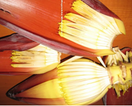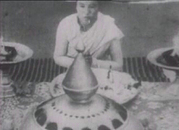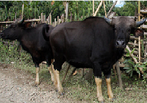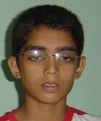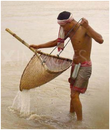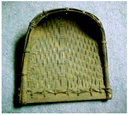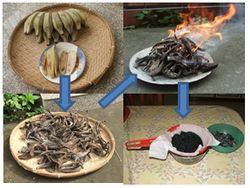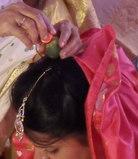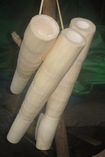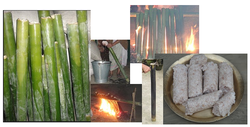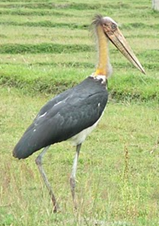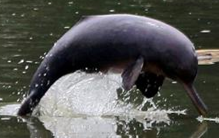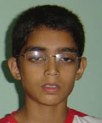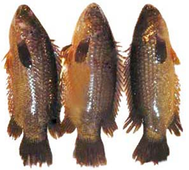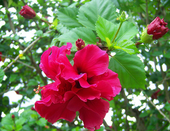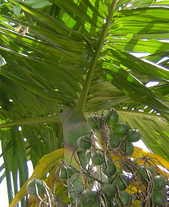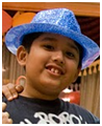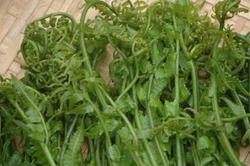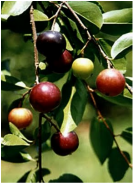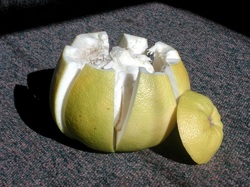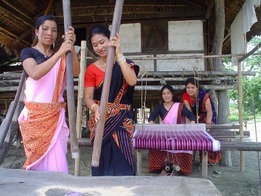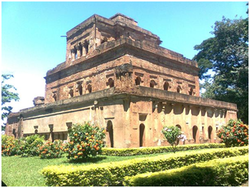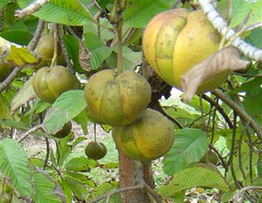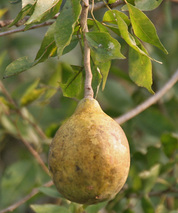I KNOW MY ASSAM# 15
|
Q1. It is a traditional form of entertainment played as a Drama in Assam. The story generally depicts some initial superficial triumph of evils over good, but it shows the ultimate victory of good with intercession by the Gods. This type of drama depicts the victory of truth at the climax, generally using fictitious or mythological kings, queens, demons, Gods, soldiers etc. Real men and women play the roles of different characters. They speak dialogues in an artificial language called Brajawali/ Brajabuli (often in lyrical form). The good and bad characters indulge in fighting, depicted with ancient weapons like bow and arrow and swords. The entire drama is performed in the middle open space of Namghar.
Name this type of traditional drama of Assam? IDENTIFY THE CHARACTERS
|
WINNERS
|
I KNOW MY ASSAM# 14
|
Q1. Between 1817 and 1826 the Ahom Kingdom in Assam was under the control of the Burmese rulers. The period ended with the defeat of the Burmese and the subsequent annexation of the kingdom to British territory. This was the peace treaty that ended the First War between the British and the Burmese. According to the treaty, the Burmese agreed to cede Assam and other regions to the British. The treaty ended the longest and most expensive war in British Indian history. Fifteen thousand European and Indian soldiers died, together with an unknown (but almost certainly higher) number of Burmese. The campaign cost the British five million pounds sterling (roughly 18.5 billion in 2006 US dollars) to 13 million pounds sterling; this expenditure led to a severe economic crisis in British India in 1833.
1A. Name this Important treaty which changed the history of Assam? 1B. How did the treaty get its name? |
WINNERS
|
I KNOW MY ASSAM# 13
I KNOW MY ASSAM# 12
|
Q1. This Medical College was formally established on November 3, 1947. It was, however, earlier founded in 1900 by the British. It has the distinction of being the first medical college in the entire North-eastern region of India. Some buildings are modifications of the original British architecture, although several new constructions have come up recently under the joint collaboration of both the North Eastern Council and State Government to upgrade the college to a premier medical institution of Asia once again.
Name this Medical College of Assam as it is known now. Also Name this institution as it was known earlier during the British rule. |
WINNERS
|
I KNOW MY ASSAM# 11
I KNOW MY ASSAM# 10
I KNOW MY ASSAM# 9
|
1. Prior to the making of this bridge over Brahmaputra the entire North Bank of the Brahmaputra Valley was connected to the rest of the country through a rail-cum-road bridge at Saraighat, which was built in 1962 by Indian Railways. This second bridge over the River Brahmaputra near Tezpur was constructed from 1981 to 1987 and connects Sonitpur on the north bank with Nagaon District on the south bank. The length of this bridge is 3015 meters. This road bridge has been named after an illustrious Ahom General.
Name the Ahom General and the bridge? |
WINNERS
|
I KNOW MY ASSAM# 8
|
1. This is the largest river island in India. Originally the total area of this island was 1250 sq. kms., But having lost significantly to erosion it had an area of only 421.65 square kilometres in 2001. The island is formed by the Brahmaputra river in the south and the Kherkutia Xuti, an anabranch of the Brahmaputra, joined by the Subansiri River in the north. The island is about 200 kilometres east from the state's largest city — Guwahati, and is accessible by ferries from the town of Jorhat. The island was formed due to course changes by the river Brahmaputra and its tributaries, mainly the Lohit. This island is also the abode of the Assamese neo-Vaisnavite culture. Name this famous River Island?
|
WINNER
|
I KNOW MY ASSAM# 7
|
1. Assam produces three unique varieties of silks, the Golden Muga, the White Pat and the warm Eri Silks. These are utilized in on one of the world's largest weaving villages often called the Manchester of the East. The entire population here is engaged in weaving exquisite silk fabrics. This place is a renowned Centre of silk production, particularly known for Muga - the golden silk of Assam which is not produced anywhere else in the world. This is the textile center of Assam. Muga silk and Pat silk along with Eri silk and Endi cloth from this region is famous for its quality. Mekhela chadors and Gamosas made from these indigenous materials is in demand throughout Assam as well as other parts of India. Name this famous Village?
|
WINNERS
|
I KNOW MY ASSAM#6
|
1. This Temple on Nilachal Hill, eight km west of the Guwahati city, is believed to be an ancient 'Khasi' sacrificial site. It has been a part and parcel of Assamese life and culture from ancient times. The temple dedicated to a Goddess is one of the oldest and most sacred centre for Shakti worship and Tantric Hinduism. The sikhara or spire is in the shape of a beehive and it has the nymph motifs and the long turtle back hall. The stone images and other relics found around the temple have been dated by archaeologists to the eighth century onwards. It attracts pilgrims from all over India, especially during the Ambubachi Festival which usually falls around July. The ponds here are home to some giant turtles. There is a majestic view of the city and the Brahmaputra river from the hill top. Name this Temple?
Q2. IDENTIFY THE ITEMS IN THE PICTURES.
|
WINNERS
|
I KNOW MY ASSAM#5
|
1. The Battle of Saraighat was fought in 1671 between the Mughal empire (led by the Kachwaha king, Raja Ramsingh I), and the Ahom Kingdom on the Brahmaputra river at Saraighat, now in Guwahati. Although much weaker, the Ahom Army defeated the Mughal Army by brilliant uses of the terrain, clever diplomatic negotiations to buy time, guerrilla tactics, psychological warfare, military intelligence and by exploiting the sole weakness of the Mughal forces—its navy. The Battle of Saraighat was the last battle in the last major attempt by the Mughals to extend their empire in to Assam.
The Ahoms were led by a commander and Borphukan (councilor) in the Ahom kingdom known for his leadership that thwarted a drawn out attempt by Mughal forces. He was the son of Momai Tamuli Borbarua,the first Borbarua (Governor of upper Assam and Commander-in-Chief of the Ahom army) under Prataap Singha. He was educated in humanities, scriptures and military skills. The best passing out cadet of National Defence Academy in India, is conferred a medal named after him. Who is he? |
WINNERS
|
I KNOW MY ASSAM#4
|
1. This great Vaishnavite saint and reformer was born in Alipukhuri of Batradova, Nagaon, in 1449.He was a great scholar and literary genius. He was also a poet, dramatist, painter and sculptor. The philosophy of his religion is enriched with the essence of Vedanta, Bhaktism, monotheism, spiritualism and humanism. His eminent literary creation is the “Kirton-Ghosa”, an early Assamese poetical work. In “Gunamala” he had cryptically described the manifold qualities of Lord Krishna in a day to impress the Koch King Naranarayana. The Xatras set up by him had an important role to play in the religious and spiritual life of the people. The “Xatras’ and “Namghars” gradually turned into religious and social institutions for congregation and prayer. Who is he?
Q 2. IDENTIFY BOTH THE ACTIVITIES CARRIED OUT BY WOMEN FROM RURAL ASSAM
|
I KNOW MY ASSAM#3
I KNOW MY ASSAM#2
|
1. He was born on 17 June, 1903 in Tamulbari Tea Estate. He was a playwright, songwriter, poet, writer and film maker from Assam. He is an Assamese cultural icon, deeply revered for his creative vision and output and is popularly called the Rupkonwar of Assamese culture. He established the Chitraban Studio at the Bholaguri Tea Estate and began filming the movie Joymoti around the end of 1933. This was the first film from Assam. He is regarded as the founder of Assamese cinema for Joymati (1935). The film, released in 1935, was based on a play by Laxminath Bezbarua about a heroic Ahom princess imprisoned and tortured by a repressive Ahom Swargadeo. In 1941 he participated in the freedom movement, and in 1942, he went underground to escape British repression. His death anniversary (January 17) is celebrated as Silpi divas (Artists' Day) in his honor.
Who is this great man? 2. He was born in Dhaka on 31 January 1909. He was a multifaceted artist and revolutionary singer of Assam. In 1951, after the death of Jyoti Prasad Agarwala, he became the president of the Assam branch of Indian Peoples' Theatre Association (IPTA). His work Bano Kobang is a masterpiece which contains valuable information about ethnic groups of Asom. He was an established singer. He had learnt Borgeet of Shrimanta Shankar Deva and gave the genre a new significance for the modern times. There are more than hundred songs composed by him. Some leading numbers include ‘Xurore Deulore, ’Bilote Halise’, 'Para jonomor khubho logonor', 'logon ukali gol', 'roi roi keteki' ,'tilai tilai',' kurua botah' and many more. He was a great actor. He used to perform dramas at Bann theatre of tezpur which is regarded to be one of the oldest cultural activity centers of Assam. His paintings are still preserved in his residence at Tezpur. His art works are considered to be master piece, as it were worked on with such a great perfection even at that time. Who are we talking of? |
WINNERS
|
I KNOW MY ASSAM#1
|
1. He was the Prince who quarreled with his brother and left the kingdom in the Tai state of Mong Mao in Yunan Province, in the 13th Century to settle down in Charaideo, Assam. He had a following of three queens, two sons and a daughter, five nobles and 9,000 men, women and children. He had with him two elephants and 300 horses. He founded the Ahom kingdom in Assam. In reverence to his position in Assam's history the honorific Chaolung is generally associated with his name. He was one of the most romantic figures in the history of Eastern India. He was extraordinarily enterprising and brave. He plunged into a risky adventure to found a kingdom in a land which was wholly unknown to him.
Who is he? 2. This division of the Kachari Family of North East India engaged in gold panning of river sand, during the reign of the Ahom kings. The great king Boli Raja, mentioned in Bishnu Purana, who was exiled to Patal Puri by Lord Bishnu, is said to be their ancestor. They are predominantly inhabitants of Dhemaji, Lakhimpur, Tinisukia and Dibrugarh district of Assam. Name this tribe? |
WINNERS
|








